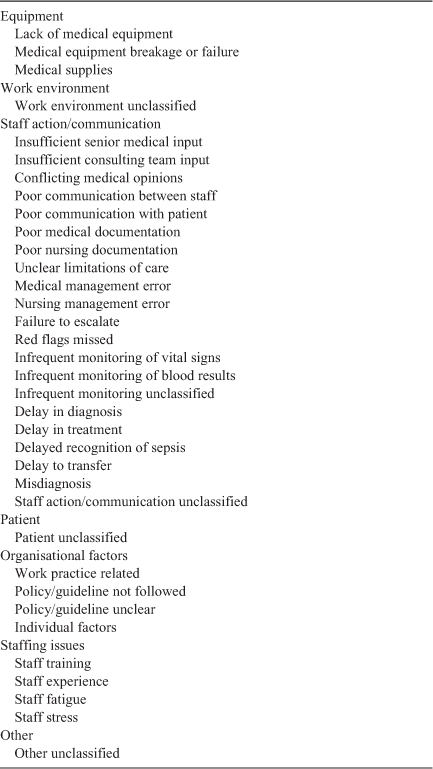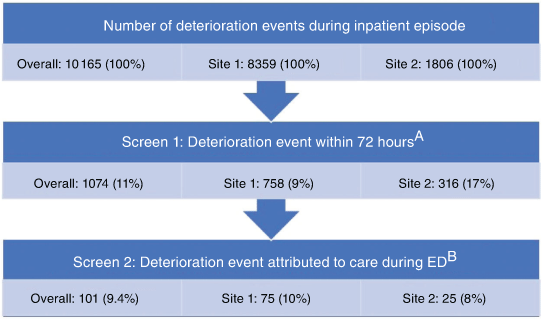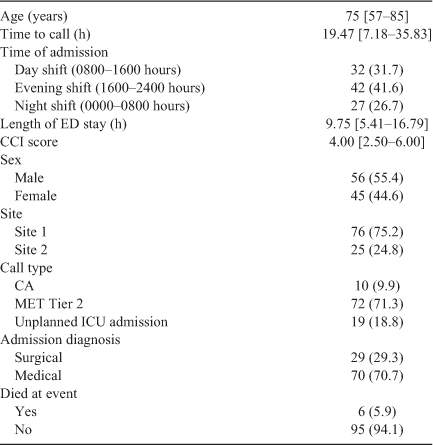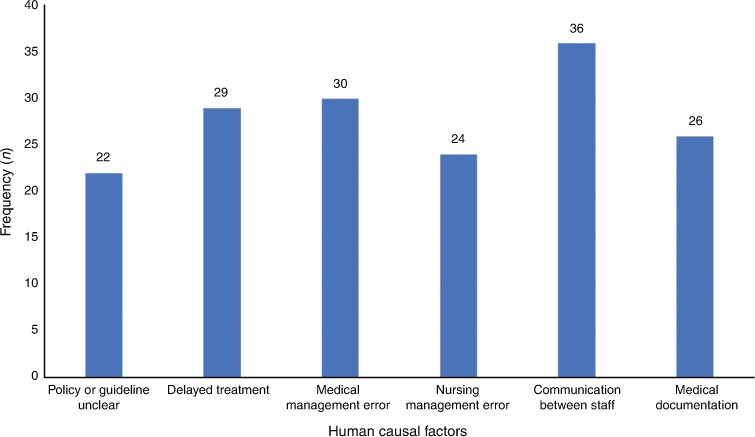Emergency department care-related causal factors of in-patient deterioration
Kirollos Nassief A F G , Mark Azer B , Michael Watts C , Erin Tuala C , Peter McLennan A and Kate Curtis C D E
C D E
A Faculty of Science, Medicine and Health, University of Wollongong, NSW, Australia. Email: petermcl@uow.edu.au
B South Eastern Sydney Local Health District, Kogarah, Sydney, NSW, Australia. Email: mark.azer@health.nsw.gov.au
C Illawarra Shoalhaven Local Health District, Wollongong, NSW, Australia. Email: michael.watts@health.nsw.gov.au; erin.tuala@health.nsw.gov.au; kate.curtis1@health.nsw.gov.au
D Faculty of Medicine and Health, University of Sydney, NSW, Australia.
E Illawarra Health and Medical Research Institute, Keiraville, NSW, Australia.
F Present address: South Eastern Sydney Local Health District, Kogarah, Sydney, NSW, Australia.
G Corresponding author. Email: kirollos.nassief@health.nsw.gov.au
Australian Health Review 46(1) 35-41 https://doi.org/10.1071/AH21190
Submitted: 31 May 2021 Accepted: 20 July 2021 Published: 24 December 2021
Journal Compilation © AHHA 2022 Open Access CC BY-NC-ND
Abstract
Objective The aim of this study was to determine factors related to emergency department (ED) care causing in-patient deterioration.
Methods This retrospective cohort study examined in-patient records using the human factors classification framework for patient safety in a regional health service in New South Wales, Australia, between March 2016 and February 2017. Deterioration was defined as either the initiation of a medical emergency team call, cardiac arrest or unplanned admission to the intensive care unit.
Results Of the 1074 patients who deteriorated within 72 hours of admission via the ED, the care received in the ED was a contributing factor for 101 patients (9%). The most common human causal factors were poor communication between staff, medical management errors, delayed treatment, medical documentation errors, nursing management errors and unclear policies or guidelines. Communication issues occurred the most when patients had more comorbidities (P = 0.039) and were more likely to occur in the presence of a medical documentation error (odds ratio 4.4; 95% confidence interval 1.7–11.3). Unclear policies or guidelines as a factor was most frequent with a surgical diagnosis (34.5% vs 15.7% for surgical vs medical, respectively; P = 0.038) and in patients ≥80 years of age (30.0% vs 21.8% for age ≥80 vs <80 years, respectively; P = 0.027).
Conclusion Quality monitoring and interventions that consider human factors are required to address preventable in-patient deterioration.
What is known about the topic? The ED represents the hospital’s point of contact for potentially life-threatening conditions. Adverse event rates for emergency admissions are more than double those of non-emergency admissions. Patients are at particular risk of deterioration on discharge from the ED to the ward in the first 72 hours. Predicting which patients will deteriorate following transfer to the ward remains challenging, with care in the ED hypothesised to play a role.
What does this paper add? This paper reveals that in-patient deterioration relating to ED care could be reduced through the routine identification of causal factors within a human factors framework in any patient deterioration event and subsequent evidence-informed interventions to address these factors. It is also extrapolated that the implementation of any intervention should be informed by behaviour-change principles.
What are the implications for practitioners? It is implied that there is a need for the clarification and revision of policies and guidelines pertaining to the management of elderly patients, education regarding the critical importance of the often clinically masked vital sign deviations in younger patients and improved communication between staff, especially regarding patients with more comorbidities. Reviews of adverse events, such as patient deterioration, should incorporate a human factors analysis. Regular collation of data following adverse events should occur, with interventions considering all aspects of the factors that led to the event.
Introduction
The emergency department (ED) plays a crucial role for its surrounding community, being the first point of contact for often serious and life-threatening conditions. Australia’s 287 EDs treated more than 8.4 million patients in 2018–19, or 23 000 patients per day, a 4.2% increase compared with 2017–18.1 Patients generally have undiagnosed conditions and varying degrees of clinical urgency and severity.2
In 2018, the Australian Institute of Health and Welfare reported that adverse event rates for emergency admissions were more than double those of non-emergency admissions.3 An adverse event is any incident, contributed to by medical care or the absence thereof, resulting in unintended patient harm. Avoidable clinical deterioration is considered an adverse event.4 These avoidable lapses in safety and quality have substantial costs in terms of people’s lives and hospital finances.5 Considine and Currey found that 55.3% of patients who deteriorated and required a medical emergency team (MET) call were first admitted from the ED.6 This and other recent work have demonstrated that a large proportion of these patients experience deterioration within the first 72 hours after admission onto the ward, and that deterioration occurs at higher rates for those with comorbid cardiac disease, diabetes or malignancy.7,8 Lambe et al. reported that just one abnormal vital sign in ED was a strong predictor of deterioration.9 However, the specific causes of patient deterioration and the indications for escalation to a rapid response were not assessed in that study.
Human factors may also be predictive of deterioration, adding complexity to the prevention and/or detection of deteriorating patients. Inadequate ED documentation or errors therein can lead to misdiagnosis, alongside miscommunication between staff, and further decrease the chances of detecting patient deterioration.10,11 Institutional pressures to reduce ED lengths of stay to 4 h can lead to premature ward transfer. Given the limitations of a general medical/surgical ward in caring for a patient without a comprehensive and completed treatment plan, this may compromise patient safety.12,13 Medical equipment is another factor to consider, whereby desensitisation and alarm fatigue may set in, allowing for the early stages of deterioration to go unchecked.14,15
The evidence around causal factors for patient deterioration following admission to the ward setting is limited, particularly in relation to the care provided in the ED. By determining these factors, a strategy to inform change and potentially prevent further preventable deterioration episodes could be developed.
The aim of this study was to identify ED-related causal factors for in-patient deterioration events following ED discharge and, in particular, to determine whether factors such as communication between staff, delayed treatment and documentation errors increased risk.
Methods
Setting and sample
This was a retrospective cohort study conducted at two sites in a regional health service between March 2016 and February 2017. Ethics approval was obtained from the University of Wollongong and Illawarra Shoalhaven Local Health District Health and Medical Human Research Ethics Committee (LNR/16/WGONG/249).
Patient identification and data sources
Patients who had been admitted to one of the study sites via the ED and had a deterioration event within 72 hours of admission from the ED were eligible for inclusion in this study. A deterioration event was defined as a MET call, a cardiac arrest call or an unplanned admission to the intensive care unit (ICU). Data were obtained from two sources: the site MET call databases and the electronic medical record. The site MET call databases were used to identify patients who deteriorated once they had left the ED. Both sites in the regional health service employ a clinical nurse consultant (CNC) to identify and audit all patients who receive a cardiac arrest call, an unplanned admission to the ICU or a MET call. Staff activate MET calls when they are concerned patient deterioration needs immediate medical review by the MET team.
Once patients who had a deterioration event within 72 hours were identified, additional data were collected by the CNC from the electronic medical records and entered into a purpose-built database. These data included over 100 event details across eight key sections. The key sections included patient factors (e.g. pre-existing conditions, calculated using the Charlson comorbidity index (CCI)16), admission diagnosis, vital signs at the time of the deterioration call, specific services involved in care delivery, factors contributing to the care delivery problem (including equipment, work environment, staff action and organisational factors) and patient outcomes.
Classification of causal factors
The human factors classification framework for patient safety was used to collect human factors thought to play a role in leading to the patient deterioration adverse event to identify influencing or causal factors.17 This included information that may have influenced clinical practice, such as regarding equipment, work environment, staff action and patient, organisational, individual and other factors.18 This framework was adopted because previous inter-rater reliability for human factors classifications has been demonstrated to be high,19 and the approach was based on James Reason’s model of organisational incidents.20 Each causal factor was classified into one of seven categories (Table 1), then several subcategories (Table 2).

|

|
These data were collected and classified by three nurse consultants (MW, ET, KC) with expertise in clinical case peer review, current critical care, ED and coronary care experience, as well as on cardiac arrest teams. These nurse consultants reviewed patients’ clinical notes to identify any human causal factors contributing to deterioration. A data dictionary was developed in consultation with the nurse auditors (Table 2). In applying this, a single deterioration event was potentially attributed to one or multiple causal factors, as appropriate. To ensure consistency, where a causal factor did not neatly fit a single framework subcategory, a group decision was made and recorded.
For a deterioration event to be labelled as related to care received while in the ED, the causal factors identified must have had a clear relationship with or clearly contributed to the deterioration event. Examples of ED-related causal factors included a delay to intravenous antibiotics in a septic patient, missed diagnostic information (e.g. arterial blood gas in a deteriorating respiratory patient) or progressive deterioration in the ED with no identification or escalation. In contrast, if on Day 2 of admission the patient had a MET call for a postoperative complication, and it was clear the event had no link to the treatment and care provided within the ED, it would not be considered ED related.
Data analysis
Descriptive statistics were obtained for continuous data, including age, time to MET call, length of stay in the ED and CCI score. When normality was not demonstrated through either the Kolmogorov–Smirnov or Shapiro–Wilk tests, data were summarised as the median and interquartile range (IQR). Categorical data, including sex, hospital site, admission diagnosis, call type, death following event, time of admission and age group, are presented as frequencies and percentages of their respective totals.
Those human causal factors that had been linked to the deterioration of at least 20% of study participants were then incorporated into the assessment of secondary outcomes, including the relationship between such factors and patient age group, admission diagnosis, mortality at event, time of admission and CCI score. These analyses were performed using the Chi-squared test, Fisher’s exact test, Kendall’s tau-b and linear regression.
All statistical analyses were performed in SPSS version 25 (IBM Corp.).
Results
There were 10 165 patients identified as having a deterioration event over the period 1 March 2016–28 February 2017. Of these, 1074 patients deteriorated within 72 hours of admission to the ward, and 101 of these events were attributed in some way to care during the ED stay (Fig. 1).

|
Patient characteristics
The median age of patients was 75 years (IQR 57–85 years), and most were male (55.4%; Table 3). Increasing age was associated with a higher CCI score (P < 0.001). Most patients had a medical admission diagnosis (70.7%) rather than surgical. The median ED length of stay was 9.75 h (IQR 5.41–16.79 h).

|
Human causal factors of patient deterioration attributed to care while in the ED
As shown in Fig. 2, the most frequent human causal factors contributing to a deterioration event were poor communication between staff (35.6%; n = 36), medical management error (29.7%; n = 30), delayed treatment (28.7%; n = 29), medical documentation error (25.7%; n = 26), nursing management error (23.8%; n = 24) and unclear policies or guidelines (21.8%; n = 22). No individual human causal factor was associated with mortality at the deterioration event or with time of admission (Table 4). A relationship was demonstrated between the causal factor of poor staff–patient communication and a higher CCI score (P = 0.039), and poor communication between staff was fourfold more likely to occur in the presence of a medical documentation error (odds ratio (OR) 4.4; 95% confidence interval (CI) 1.7–11.3).

|
Medical management errors were associated with delayed treatment (OR 3.3; 95% CI 1.3–8.2), medical documentation errors (OR 2.7; 95% CI 1.1–6.9) and nursing management errors (OR 3.3; 95% CI 1.3–8.5). Unclear policies or guidelines as a factor was most frequent in patients aged ≥80 than <80 years (30.0% vs 21.8%, respectively; P = 0.027), and with a surgical rather than medical diagnosis (34.5% vs 15.7%, respectively; P = 0.04).
The all-factor run of a linear regression with age yielded significant results for medical management error (P = 0.045) and inadequate monitoring of observations (P = 0.002). Inadequate monitoring of observations, despite not being one of the most frequent human causal factors shown in Fig. 2, was identified as an issue in seven deterioration events (6.93%).
Discussion
This study found that human factors contribute to patient deterioration events in the first 72 hours of admission from the ED that can be attributed to care while in the ED. Of the six human factors that were the focus of this study, poor communication between staff was the leading cause of deterioration, which was heightened when the patient had multiple comorbidities. This is consistent with other literature,21 which describes a reluctance to call for the help of a senior because of the need to persuade them regarding the need for their input and fear of being thought of poorly for an incorrect judgement. Institution-wide education in communication skills focusing on increased adherence to the ISBAR (Introduction, Situation, Background, Assessment, Recommendation) framework would help circumvent this issue.22
The impact of human causal factors on deterioration among elderly patients was highlighted in this study, especially as a result of an unclear policy or guideline. There are several possible explanations for this, including that the increased comorbidities that an elderly patient presents with may cause ambiguity in the interpretation of policies or guidelines that would normally be more straightforward for less complex patients.
Medical documentation errors of inadequacy, inaccuracy and omission, including those that led to communication issues and management faults, were associated with deterioration in 25.7% of patients, and issues relating to monitoring of observations were identified in 6.93% of patients, particularly among younger patients. An explanation for the lack of monitoring of vital signs could be that the monitoring is occurring but not being documented due to time constraints and pressure to multitask in the resuscitation context.23 A solution would be the introduction of automated downloading of vital signs from the monitoring systems to the electronic medical record in the ED, similar to the processes used in ICUs around Australia.24 The documentation of vital signs becomes less vulnerable to omission of data and transcription errors through automated vital signs documentation systems, as opposed to manual documentation, with a 75% reduction in error prevalence.25
The power of this study could have been enhanced with a greater sample size, minimising the chance of Type II error. The study also did not contain a control group of patients who did not deteriorate. Although this would not have proven causality, it would have provided information on which human factors were more directly associated with the precipitating event of patient deterioration. Furthermore, the retrospective nature of the study and its dependence on medical record review inherently predispose to information and misclassification biases.
However, the risk of bias was extensively minimised through the peer review of data classification and screening by three independent auditors with broad experience in clinical case reviews, as well as clinical experience in critical care and coronary care units. A data dictionary of error classification was also composed to ensure consistency across the auditors regarding group decisions made on error classifications. Moreover, this is the first study of its kind to assess the role of human factors in the deterioration of patients on the ward following ED discharge.
Conclusion
Human factors that contribute most to episodes of patient deterioration include poor communication between staff, medical management errors, delayed treatment, medical documentation errors, nursing management errors and unclear policies or guidelines. Communication issues are more likely in the presence of a medical documentation error and in the context of patients with many comorbidities. It is recommended that reviews of adverse events, such as patient deterioration, should incorporate a human factors analysis. These data should be regularly collated to ensure all factors contributing to adverse events are constantly informing any corrective interventions.
Data availability
The data that support this study cannot be publicly shared due to ethical or privacy reasons and may be shared upon reasonable request to the corresponding author if appropriate.
Competing interests
The authors declare that they have no competing interests.
Declaration of funding
This research did not receive any specific funding.
References
[1] Australian Institute of Health and Welfare (AIHW). Emergency department care 2017–18: Australian hospital statistics. Health services series no. 89. Catalogue number HSE 216. Canberra: AIHW; 2018.[2] Fry M. Chapter 1: Emergency nursing in Australia and New Zealand. In: Curtis K, Ramsden C, Shaban R, Fry M, Considine J, eds. Emergency and Trauma Care: For Nurses and Paramedics. 3rd edn. Sydney: Elsevier Australia; 2019.
[3] Australian Institute of Health and Welfare (AIHW). Australia’s health 2018: in brief. Catalogue number AUS 222. Canberra: AIHW. 2018.
[4] Griffin F, Resar R. IHI global trigger tool for measuring adverse events (second edition). IHI Innovation Series white paper. Cambridge, MA: Institute for Healthcare Improvement; 2009.
[5] Harrison R, Walton M, Manias E, et al The missing evidence: a systematic review of patients’ experiences of adverse events in health care. Int J Qual Health Care 2015; 27 424–42.
| The missing evidence: a systematic review of patients’ experiences of adverse events in health care.Crossref | GoogleScholarGoogle Scholar | 26424702PubMed |
[6] Considine J, Currey J. Ensuring a proactive, evidence-based, patient safety approach to patient assessment. J Clin Nurs 2015; 24 300–7.
| 24942476PubMed |
[7] Considine J, Jones D, Pilcher D, Currey J. Physiological status during emergency department care: relationship with inhospital death after clinical deterioration. Crit Care Resusc 2015; 17 257–62.
| 26640061PubMed |
[8] Considine J, Rhodes K, Jones D, Currey J. Systems for recognition and response to clinical deterioration in Victorian emergency departments. Australas Emerg Care 2018; 21 3–7.
| Systems for recognition and response to clinical deterioration in Victorian emergency departments.Crossref | GoogleScholarGoogle Scholar | 30998862PubMed |
[9] Lambe K, Currey J, Considine J. Frequency of vital sign assessment and clinical deterioration in an Australian emergency department. AENJ 2016; 19 217–22.
| Frequency of vital sign assessment and clinical deterioration in an Australian emergency department.Crossref | GoogleScholarGoogle Scholar | 27726973PubMed |
[10] Cioffi J, Conwayt R, Everist L, et al ‘Patients of concern’ to nurses in acute care settings: a descriptive study. Aust Crit Care 2009; 22 178–86.
| ‘Patients of concern’ to nurses in acute care settings: a descriptive study.Crossref | GoogleScholarGoogle Scholar | 19726207PubMed |
[11] Cioffi J, Salter C, Wilkes L, et al Clinicians’ responses to abnormal vital signs in an emergency department. Aust Crit Care 2006; 19 66–72.
| Clinicians’ responses to abnormal vital signs in an emergency department.Crossref | GoogleScholarGoogle Scholar | 16764154PubMed |
[12] Nash L, Tacey M, Liew D, et al Impact of emergency access targets on admissions to general medicine: a retrospective cohort study. Intern Med J 2013; 43 1110–6.
| Impact of emergency access targets on admissions to general medicine: a retrospective cohort study.Crossref | GoogleScholarGoogle Scholar | 23941165PubMed |
[13] Perera ML, Gnaneswaran N, Roberts MJ, et al The ‘four-hour target’ and the impact on Australian metropolitan acute surgical services. ANZ J Surg 2016; 86 74–8.
| The ‘four-hour target’ and the impact on Australian metropolitan acute surgical services.Crossref | GoogleScholarGoogle Scholar | 26096442PubMed |
[14] Vincent J-L, Einav S, Pearse R, et al Improving detection of patient deterioration in the general hospital ward environment. Eur J Anaesthesiol 2018; 35 325–33.
| Improving detection of patient deterioration in the general hospital ward environment.Crossref | GoogleScholarGoogle Scholar | 29474347PubMed |
[15] Curry JP, Jungquist CR. A critical assessment of monitoring practices, patient deterioration, and alarm fatigue on inpatient wards: a review. Patient Saf Surg 2014; 8 29
| A critical assessment of monitoring practices, patient deterioration, and alarm fatigue on inpatient wards: a review.Crossref | GoogleScholarGoogle Scholar | 25093041PubMed |
[16] Quan H, Li B, Couris CM, et al Updating and validating the Charlson comorbidity index and score for risk adjustment in hospital discharge abstracts using data from 6 countries. Am J Epidemiol 2011; 173 676–82.
| Updating and validating the Charlson comorbidity index and score for risk adjustment in hospital discharge abstracts using data from 6 countries.Crossref | GoogleScholarGoogle Scholar | 21330339PubMed |
[17] Mitchell RJ, Williamson A, Molesworth B. Application of a human factors classification framework for patient safety to identify precursor and contributing factors to adverse clinical incidents in hospital. Appl Ergon 2016; 52 185–95.
| Application of a human factors classification framework for patient safety to identify precursor and contributing factors to adverse clinical incidents in hospital.Crossref | GoogleScholarGoogle Scholar | 26360210PubMed |
[18] Curtis K, Mitchell R, McCarthy A, et al Development of the major trauma case review tool. Scand J Trauma Resusc Emerg Med 2017; 25 20
| Development of the major trauma case review tool.Crossref | GoogleScholarGoogle Scholar | 28241880PubMed |
[19] Mitchell R, Williamson A, Molesworth B. Identifying causal patterns and errors in adverse clinical incidents. Paper presented at Contemporary Ergonomics and Human Factors 2013: Proceedings of the International Conference on Ergonomics and Human Factors; 15–18 April 2013; Cambridge, UK.
[20] Reason J. Human error: models and management. BMJ 2000; 320 768–70.
| Human error: models and management.Crossref | GoogleScholarGoogle Scholar | 10720363PubMed |
[21] Odell M, Victor C, Oliver D. Nurses’ role in detecting deterioration in ward patients: systematic literature review. J Adv Nurs 2009; 65 1992–2006.
| Nurses’ role in detecting deterioration in ward patients: systematic literature review.Crossref | GoogleScholarGoogle Scholar | 20568317PubMed |
[22] Curtis K, Tzannes A, Rudge T. How to talk to doctors – a guide for effective communication. Int Nurs Rev 2011; 58 13–20.
| How to talk to doctors – a guide for effective communication.Crossref | GoogleScholarGoogle Scholar | 21281287PubMed |
[23] Sarcevic A. ‘Who’s scribing?’: documenting patient encounter during trauma resuscitation. Proceedings of the SIGCHI Conference on Human Factors in Computing Systems; 10–15 April 2010; Atlanta, GA, USA.
[24] Fuller T, Fox B, Lake D, Crawford K. Improving real-time vital signs documentation. Nurs Manage 2018; 49 28–33.
| Improving real-time vital signs documentation.Crossref | GoogleScholarGoogle Scholar | 29287047PubMed |
[25] Meccariello M, Perkins D, Quigley LG, et al Vital time savings: evaluating the use of an automated vital signs documentation system on a medical/surgical unit. J Healthc Inf Manag 2010; 24 46–51.



